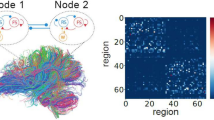Abstract
Cross-correlation functions were used to study the time delay (a measure of synchronization) in the appearance of epileptic discharges in distant areas of the cortex in the intact cortex and in neuronally isolated cortical strips in Wistar rats. Experiments were performed at different stages of axon sprouting 30 and 90 days after isolation of cortical areas and in intact cortex. Significant increases in the number of synapses in layer V of isolated cortical strips at 30 days correlated with significant decreases in the time delay, while decreases in the number of synapses at 90 days correlated with a significant increase in the time delay. This is evidence that newly formed synapses increase the extent of synchronization and thus affect epileptogenesis. The data obtained here suggest that large pyramidal cells in layer V of the rat neocortex form a neural network in pathological conditions, this supporting intracortical synchronization of epileptic discharges.
Similar content being viewed by others
REFERENCES
N. S. Kositsyn and N. V. Pasikova, “Specific characteristics of structural phasic rearrangements in a region of the cerebral cortex of the brain in conditions of complete and prolonged neuronal isolation,” Dokl. Ros. Akad. Nauk., 376,No. 6, 833–835 (2001).
V. G. Marchenko, “Spatial synchronization of potentials in baseline and evoked EcoG of neuronally isolated strips of cortex in rabbits,” Zh. Vyssh. Nerv. Deyat., 43,No. 6, 1196–1201 (1993).
N. V. Pasikova, V. G. Marchenko, and N. S. Kositsyn, “The structural bases of intracortical processes underlying the synchronization of epileptic potentials in the sensorimotor area of the rat neocortex,” Ros. Fiziol. Zh. im. I. M. Sechenova, 86,No. 5, 532–540 (2000).
N. V. Pasikova, V. G. Marchenko, and N. S. Kositsyn, “Development and application of a method for isolating areas of neocortex in small animals for long-term studies,” Zh. Vyssh. Nerv. Deyat., 49,No. 2, 355–358 (1999).
P. C. Bush, D. A. Prince, and D. M. Kanneth, “Increased pyramidal excitability and NMDA conductance can explain post-traumatic epileptogenesis without disinhibition: model,” J. Neurophysiol., 82,No. 4, 1748–1758 (1999).
Y. Chagnac-Amitai, H. J. Luhmann, and D. A. Prince, “Burst generating and regular spiking layer 5 pyramidal neurons of rat neocortex have different morphological features,” J. Comp. Neurol., 296, 598–603 (1990).
R. D. Chervin, P. A. Pierce, and B. W. Connors, “Periodicity and directionality in the propagation of epileptiform discharges across neocortex,” J. Neurophysiol., 60,No. 5, 1695–1713 (1998).
B. W. Connors, “Initiation of synchronized neuronal bursting in neocortex,” Nature, 310,No. 5979, 685–687 (1984).
C. D. Gilbert and T. N. Wiesel, “Columnar specificity of intrinsic horizontal and corticocortical connections in cat visual cortex,” J. Neurosci., 9,No. 7, 2432–2442 (1989).
C. D. Gilbert and T. N. Wiesel, “Morphology and intracortical projections of functionally characterized neurones in the cat visual cortex,” Nature, 280,No. 5718, 120–125 (1979).
D. J. Golomb, “Model of neuronal transient synchrony during propagation of activity through neocortical circuitry,” J. Neurophysiol., 79,No. 1, 1–12 (1998).
M. G. Gutnick, B. W. Connors, and D. A. Prince, “Mechanisms of neocortical epileptogenesis in vitro,” J. Neurophysiol., 42,No. 6, 1321–1335 (1982).
S. N. Hoffman and D. A. Prince, “Epileptogenesis in immature neocortical slices induced by 4-aminopyridine,” Brain Res., 85,No. 1, 64–70 (1995).
J. Holsheimer and F. H. Lopes da Silva, “Propagation velocity of epileptiform activity in the hippocampus,” Exptl. Brain Res., 77,No. 1, 69–78 (1989).
J. Lubke, H. Markram, M. Frotsher, and B. Sakman, “Frequency and dendritic distribution of autapses established by layer 5 pyramidal neurons in the developing rat neocortex: comparison with synaptic innervation of adjacent neurons of the same class,” J. Neurosci., 15, 16, No. 10, 3209–3218 (1996).
D. Neckelmann, F. Amzica, and M. Steriade, “Spike-wave complexes and fast components of cortically generated seizures. III. Synchronizing mechanisms,” J. Neurophysiol., 80,No. 3, 1480–1494 (1998).
D. Prince and G. Tseng, “Epileptogenesis in chronically injured cortex: in vitro studies,” J. Neurophysiol., 69,No. 4, 1276–1289 (1993).
P. Salin, G. F. Tseng, S. Hofman, et al., “Axonal sprouting in layer V pyramidal neurons of chronically injured cerebral cortex,” J. Neurosci., 15,No. 12, 8234–8245 (1995).
P. A. Schwartzkroin and D. A. Prince, “Cellular and field potential properties of epileptogenic hippocampal slices,” Brain Res., 147,No. 1, 117–130 (1978).
S. Sharpless and L. Halpern, “The electrical excitability of chronically isolated cortex studied by means of permanently implanted electrodes,” EEG Clin. Neurophysiol., 14,No. 1, 244–255 (1962).
D. Y. T'so, C. D. Gilbert, and T. N. Wiesel, “Relationship between horizontal interactions and functional architecture in cat striate cortex as revealed by cross-correlation analysis,” J. Neurosci., 6,No. 6, 1160–1170 (1986).
A. E. Telfeian and B. W. Connors, “Layer-specific pathways for the horizontal propagation of epileptiform discharges in neocortex,” Epilepsia, 39,No. 7, 700–708 (1998).
R. Traub, J. Jefferys, and M. Whittington, “Enhanced NMDA conductance can account for epileptiform activity induced by low Mn2+ in the rat hippocampal slice,” J. Physiol., 478, 379–393 (1994).
R. Traub, R. Miles, and J. Jefferys, “Synaptic and intrinsic conductance shape picrotoxin induced synchronized after-discharge in guinea-pig hippocampal slice,” J. Physiol., 461, 525–547 (1993).
Y. Tsau, Li Guan, and J.-Y. Wu, “Initiation of spontaneous epileptiform activity in the neocortical slice,” J. Neurophysiol., 80,No. 2, 978–982 (1998).
W. J. Wadman and M. J. Gutnick, “Non-uniform propagation of epileptiform discharge in brain slices of rat neocortex,” Neurosci., 52,No. 2, 255–262 (1993).
B. Y. Wong and D. A. Prince, “The lateral spread of ictal discharges in neocortical brain slices,” Epilepsy Res., 7,No. 1, 29–39 (1990).
Author information
Authors and Affiliations
Rights and permissions
About this article
Cite this article
Marchenko, V.G., Pasikova, N.V. & Kositsyn, N.S. Intracortical Synchronization of Epileptic Discharges at Different Stages of Ultrastructural Rearrangements in a Completely Neuronally Isolated Area of Rat Neocortex. Neurosci Behav Physiol 34, 307–313 (2004). https://doi.org/10.1023/B:NEAB.0000018737.64204.ca
Issue Date:
DOI: https://doi.org/10.1023/B:NEAB.0000018737.64204.ca




